Key Points
- ANOMA is a new blockchain protocol centered around Intent, designed for security, composability, and cross-chain collaboration.
- The XAN token (code not yet confirmed) will serve as the core asset of the upcoming ANOMA mainnet, used for staking, governance, and incentivizing Solvers.
- As a precursor network to the ANOMA tech stack, the NAM token is currently live on the Namada privacy chain, supporting staking, privacy rewards, and governance functions.
- ANOMA introduces a completely new user experience: you only need to express "what you want to do," rather than "how to do it," leaving the rest to the network.
- Cross-chain execution is a fundamental feature of the ANOMA architecture, supporting seamless DeFi, NFT, and multi-chain collaborative applications.
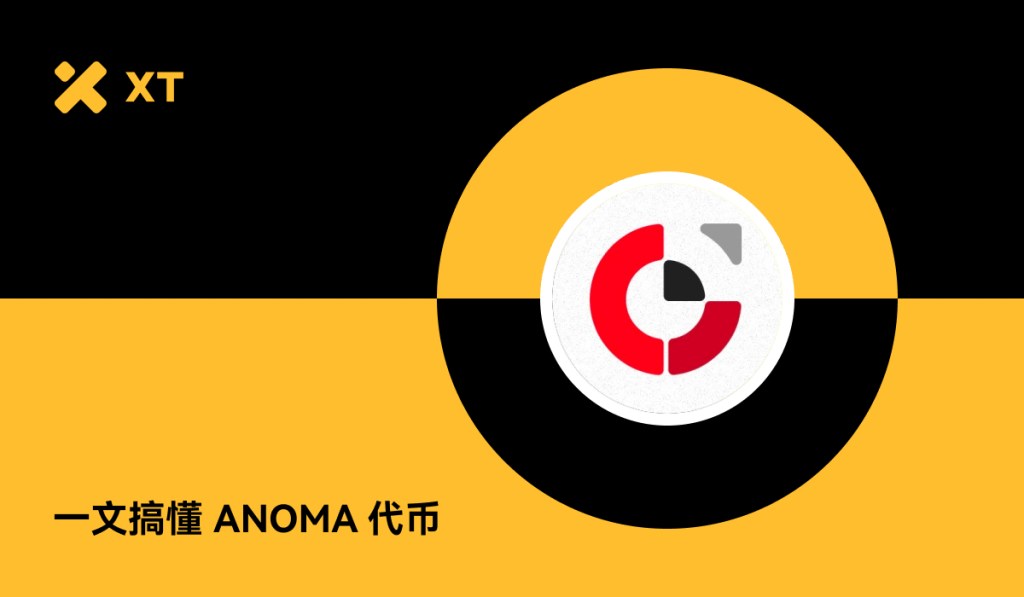 Still suffering from lagging dApps, frequent wallet switches, and a complete lack of privacy?
Still suffering from lagging dApps, frequent wallet switches, and a complete lack of privacy?
ANOMA aims to change all of this: you just need to say "what you want to do," and the network will automatically complete it for you.
It inherently supports privacy and cross-chain functionality, making it a public chain tailored for the next generation of decentralized applications.
Currently, the NAM token is live on the Namada** privacy chain**, supporting staking, privacy rewards, and governance functions. At the same time, it serves as a precursor network to the ANOMA tech stack, helping to validate and refine its underlying mechanisms.
The XAN token (code pending) will be launched alongside the ANOMA mainnet, driving the operation of the entire ANOMA ecosystem.
In this guide, we will provide a complete understanding of the relationship between them and how you can participate.
Table of Contents
Overview of the ANOMA (XAN) Project
ANOMA Token Model, Distribution Mechanism, and Burn Design
Core Applications and Ecosystem Projects of ANOMA
How to Participate in ANOMA and Obtain Tokens
Analysis of ANOMA's Competitive Advantages
Risks and Considerations of ANOMA Tokens
Future Prospects of ANOMA (XAN)
Overview of the ANOMA (XAN) Project
ANOMA is fundamentally redefining how blockchains operate. Traditional blockchains require users to build complex transaction processes step by step, while ANOMA introduces a new "Intent-driven execution" mechanism. You only need to tell the system what you want to do, such as exchanging ETH for USDC, transferring an NFT, or participating in a multi-party transaction, and the network will automatically complete the rest.
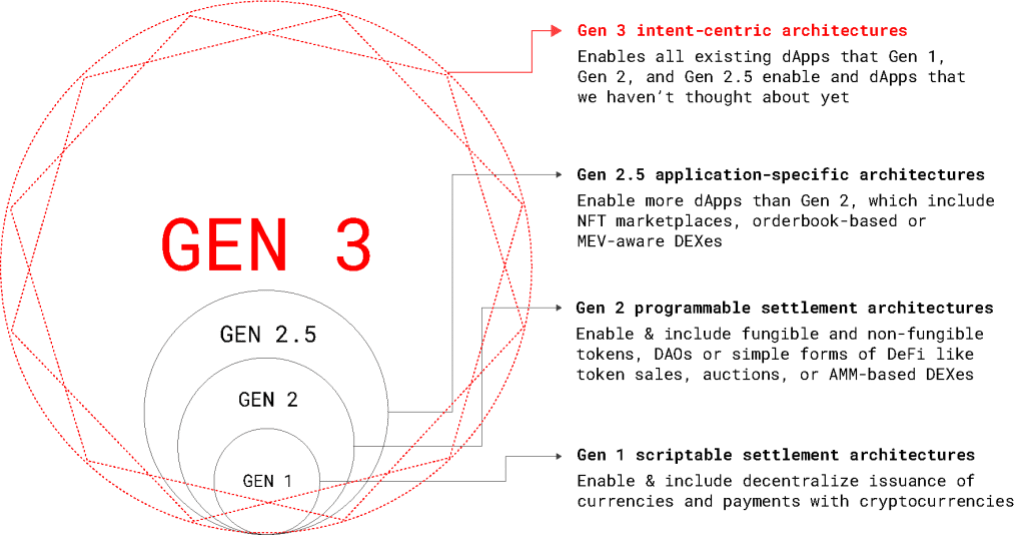 Image Credit:Anoma Learn
Image Credit:Anoma Learn
The core of this system is the "Solver." They are key participants in the peer-to-peer intent network that find matches and combine user intents into atomic-level transactions. You no longer need to switch authorizations between multiple wallets and bridging tools; cross-chain operations can be completed in one go.
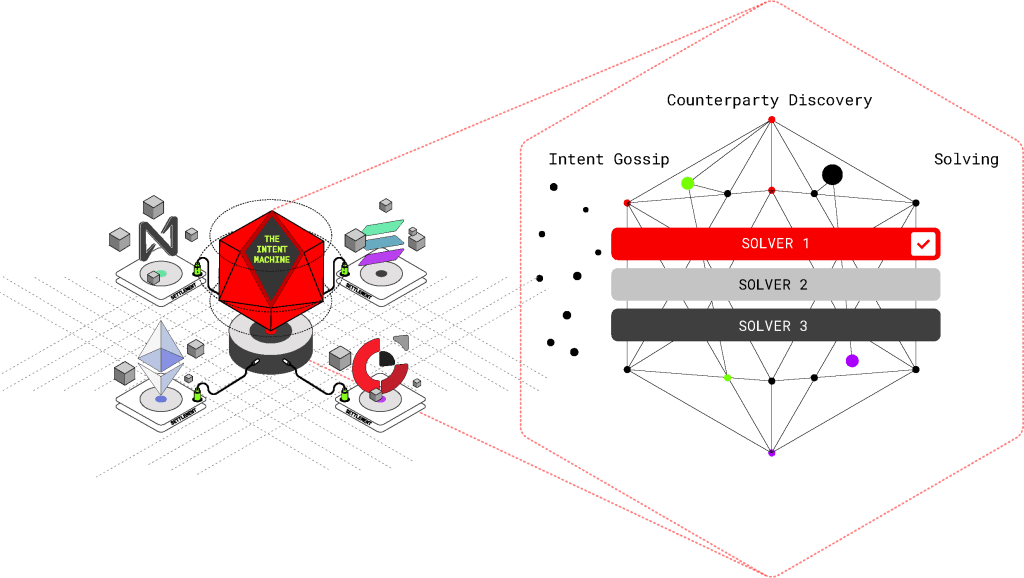 Image Credit:Anoma Learn
Image Credit:Anoma Learn
ANOMA also makes privacy the default configuration, using advanced zero-knowledge proof technology and a unified privacy pool, allowing users to keep amounts, addresses, and even transaction logic confidential during cross-chain transactions.
Namada** is the first on-chain application instance of ANOMA's technology**, an independent privacy public chain that now supports private transactions and lays the foundation for ANOMA's ecosystem.
 _Click to view YouTube video: _Namada's presentation at Cosmoverse Balkan 2025
_Click to view YouTube video: _Namada's presentation at Cosmoverse Balkan 2025
The entire ecosystem currently includes two main tokens:
- NAM token: Currently live on the Namada chain, supporting staking, privacy rewards, and on-chain governance functions.
- XAN token (code not yet finalized): Will be launched with the ANOMA mainnet as the core token of the entire cross-chain coordination network.
In ANOMA's design, users only need to express "what I want to do," without worrying about "how to do it." The goal is to make Web 3 simpler, safer, and more flexible.
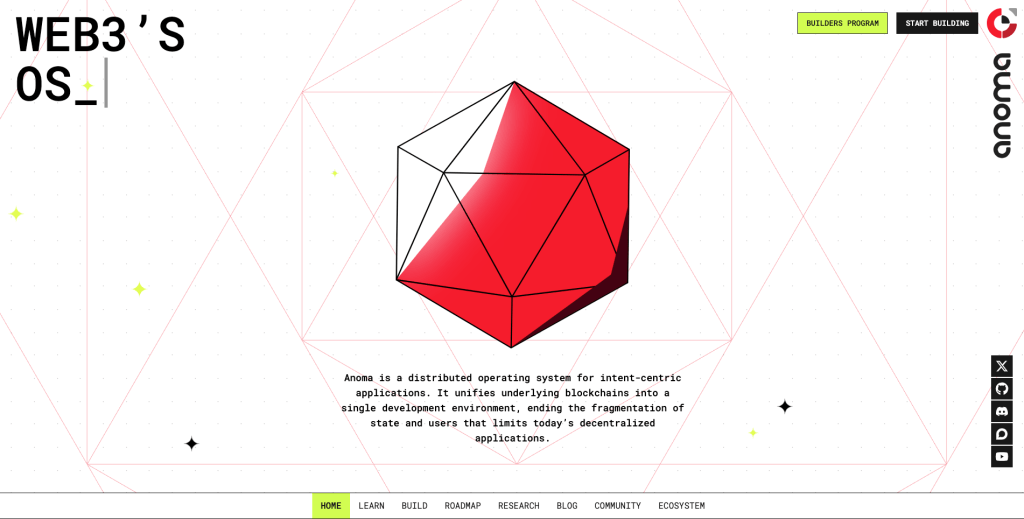 Image Credit:Anoma Official Homepage
Image Credit:Anoma Official Homepage
ANOMA Token Model, Distribution Mechanism, and Burn Design
Currently, the ANOMA ecosystem is driven by the NAM token with a total issuance of 1 billion tokens and no lock-up. This "completely open" issuance method allows all users to freely acquire tokens from day one, with the market naturally determining the price, avoiding artificial scarcity.
Main Uses of NAM
NAM is live on the Namada chain and can be used for:
- Paying on-chain transaction fees
- Participating in staking and earning validator rewards
- Participating in governance voting
- Earning additional rewards by transferring assets into the privacy pool
One highlight is that users can earn extra rewards by placing assets into Namada's privacy pool. This mechanism enhances the overall privacy of the network and encourages more people to participate in "obfuscation operations."
Distribution of NAM Tokens
 Image Credit:Namada Blog
Image Credit:Namada Blog So what is the XAN token?
So what is the XAN token?
A brand new token will be launched when the ANOMA mainnet goes live, commonly referred to as the XAN token (note: the code has not yet been finalized, and the official name has not been announced).
The mainnet is expected to launch by the end of 2025, likely between November and December, at which point ANOMA will officially transition from the testing phase to the production network and activate this new core token.
In the future, XAN will play the following key roles:
- Used for staking on the ANOMA network
- Used to pay Solvers and transaction execution-related fees
- Empowering the on-chain governance mechanism
In the early support plan (such as Intents Initiates), the official mentioned that 25 million XAN would be reserved for ecological incentives and distribution. This also implies that users holding NAM** may have the opportunity to receive a portion of the XAN distribution in the future**, but *specific airdrop or exchange rules have not yet been announced*.
Currently, both NAM and XAN do not have a burn mechanism, but community discussions on inflation control, reward adjustments, and supply sustainability are already underway.
 _Click to view the ANOMA mainnet launch roadmap: _Anoma Blog
_Click to view the ANOMA mainnet launch roadmap: _Anoma Blog
Core Applications and Ecosystem Projects of ANOMA
ANOMA is redefining the way decentralized applications (dApps) are built. Users no longer need to manually fill in the details of each transaction; they simply express their "Intent," and a Solver will automatically complete the entire operation process for them. This transformative mechanism opens up many powerful and flexible use cases.
What Can Intent-Driven dApps Achieve?
 Atomic Multi-Party Transactions
Atomic Multi-Party Transactions
- Imagine three people exchanging assets to form a closed loop; ANOMA can package the intents of all three parties into a single transaction, which will only execute when everyone achieves their goals.
Cross-Chain DeFi
- Borrowing on Ethereum and buying NFTs on Solana in one go. No manual operations or bridging required; the system automatically completes the coordination.
Privacy Transactions and Transfers
- With zero-knowledge proofs and a unified privacy pool, users can maintain the privacy of amounts, addresses, and transaction logic while still operating on-chain.
Programmable Conditional Logic
- You can set conditions such as price ceilings, KYC verification, and time windows, making dApps more flexible and secure.
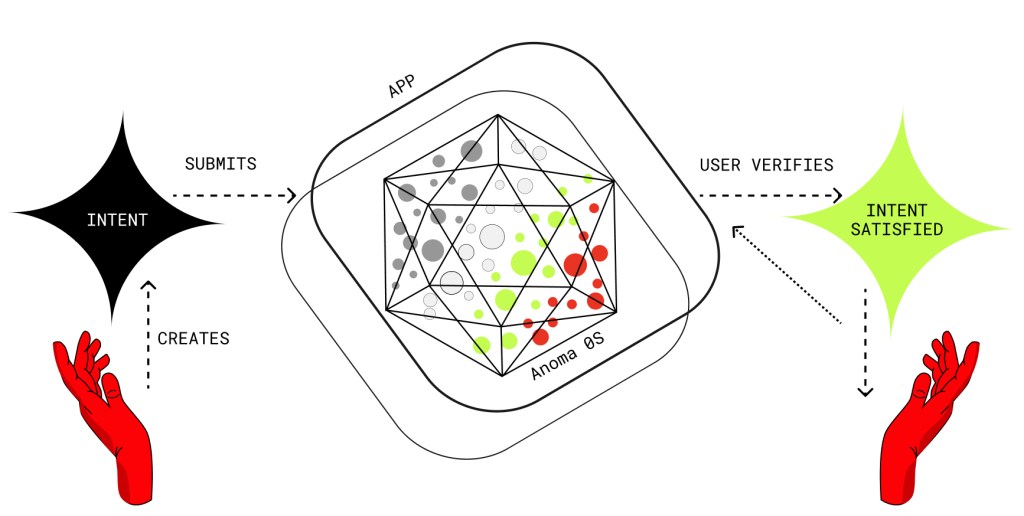 Image Credit:Anoma Learn
Image Credit:Anoma Learn
Current Ecosystem Project Overview
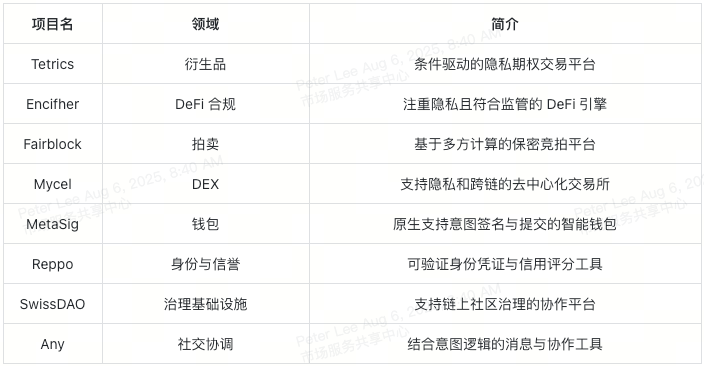 Among them, Namada is the core privacy chain of the ANOMA ecosystem, powered by the NAM token. Namada supports IBC cross-chain connections and has collaborated with projects like Osmosis to launch cross-chain privacy transactions.
Among them, Namada is the core privacy chain of the ANOMA ecosystem, powered by the NAM token. Namada supports IBC cross-chain connections and has collaborated with projects like Osmosis to launch cross-chain privacy transactions.
Currently, a batch of dApps built around the ANOMA architecture is continuously emerging, including but not limited to:
- Tetrics: A platform supporting privacy option trading
- Encifher: A DeFi engine focused on compliance and privacy protection
- Fairblock: Confidential auctions based on multi-party computation (MPC)
- Mycel: A decentralized exchange supporting cross-chain and privacy transactions
- MetaSig: A smart wallet natively supporting intent expression
- Reppo, SwissDAO, Any: Experimental projects exploring new fields such as AI, social coordination mechanisms, and identity systems
With the improvement of ANOMA's dedicated smart contract language Juvix and the advancement of developer incentive programs, more ecosystem projects are accelerating development, and the entire dApp ecosystem is expected to expand rapidly after the mainnet launch.
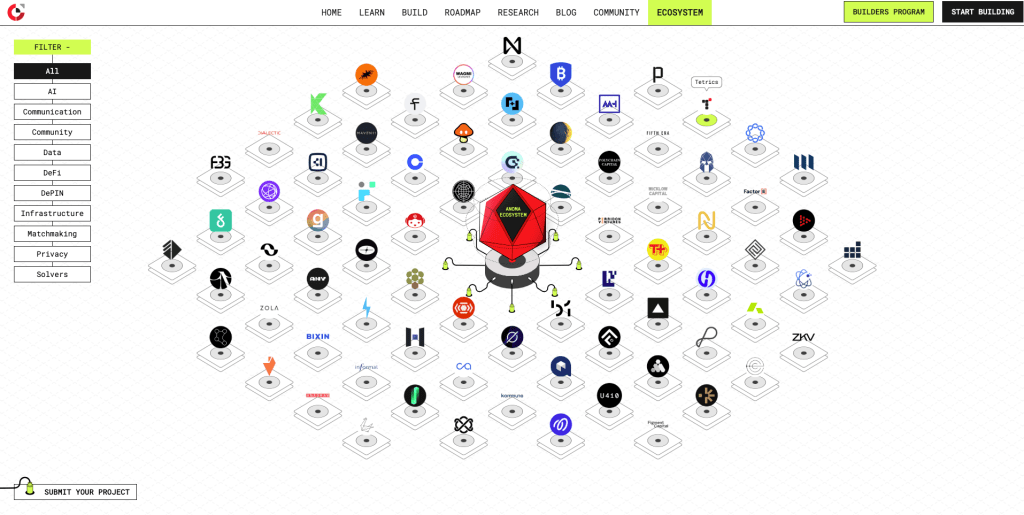 Image Credit:Anoma Interactive Ecosystem Overview
Image Credit:Anoma Interactive Ecosystem Overview
How to Participate in ANOMA and Obtain Tokens
Currently, the token that has been launched in the ANOMA ecosystem is NAM, which is the core asset of the Namada privacy chain. If you want to participate, you can start from the following aspects:
1. Trade NAM
- Trade on decentralized exchanges (such as Osmosis), supporting trading pairs like NAM/USDT, NAM/ATOM, etc.
- Purchase through brokerage platforms like Bitcoin Suisse, which also supports staking.
- Buy and sell on some centralized exchanges that support privacy assets.
2. Stake NAM to Earn Validator Rewards: Support network security while earning a certain annual yield.
3. Shield Assets to Earn Privacy Rewards: Transfer assets into Namada's shield pool to earn additional rewards through the inflation mechanism.
4. Participate in the Maspura Testnet
- Experience ANOMA's core features by running a validator node, using the MetaSig wallet, or testing dApps in the ecosystem.
- Active participants will have the opportunity to earn XAN token rewards in the future.
- To join the testnet, you need an invitation code, which you can apply for in ANOMA's official Discord community or follow their official X (formerly Twitter) account for related announcements.
As for the upcoming mainnet token, it is currently referred to as XAN (the code has not yet been officially confirmed) and is not yet open for trading, but it is expected to start circulating around the launch of the ANOMA mainnet.
It is recommended to keep an eye on ANOMA's official channels for the latest information on launch times, airdrop rules, and early participation methods.
 Image Credit:Anoma Testnet
Image Credit:Anoma Testnet
Analysis of ANOMA's Competitive Advantages
ANOMA is at the intersection of three key tracks in Web 3: cross-chain interoperability, privacy protection, and user-centric blockchain design. Let's take a look at its advantages and differences compared to other mainstream projects and protocols:

Ethereum and Its Layer 2 Networks
Ethereum (ETH) remains the most active smart contract platform today, but its core mechanism is still based on traditional transaction models, requiring users to manually execute each step. Although Layer 2 networks perform well in reducing gas fees, they still inherit Ethereum's original structure at the design level.
ANOMA, on the other hand, is completely different; it is fundamentally reconstructed with "intent at its core" and natively integrates privacy protection and cross-chain collaboration.
Cosmos and IBC Networks
Cosmos (ATOM) achieves communication between different blockchains through the IBC protocol, suitable for modular development. However, actual inter-chain coordination still relies on relayers or external bridging tools.
ANOMA takes it a step further by enabling atomic-level multi-chain transactions without shared orderers, bridging the combinatorial logic between chains.
Privacy Chains: Aztec, Aleo, Penumbra
Projects like Aztec, ALEO, and Penumbra focus on on-chain privacy protection using zero-knowledge proof technology. However, they are mainly limited to their own single ecosystems.
In contrast, ANOMA offers a cross-chain, cross-asset type private intent mechanism, greatly expanding the possibilities for complex privacy coordination.
DeFi Intent Matching: CoW Swap and UniswapX
COW and UNI optimize users' trading intents through solvers or matchers, but are limited to DeFi scenarios, with relatively restricted functionality.
ANOMA promotes the "intent-driven model" throughout the entire dApp ecosystem, allowing cross-chain transactions, DAO execution, and on-chain activity coordination to be accomplished through intent.
Core Advantage: Composability
ANOMA's greatest advantage lies in its flexibility. An intent can be:
- A simple exchange operation;
- A conditional exchange involving multiple participants;
- A combination of cross-chain NFTs and tokens;
- A one-time multi-party collaboration paired with an identity reputation system.
All of these can be completed in a single atomic transaction, without users having to worry about execution details.
Risks and Considerations of ANOMA Tokens
Like all cutting-edge blockchain projects, ANOMA faces several challenges that users and developers need to be aware of. While the vision is grand, there are still many key points to focus on for implementation.
High Learning Curve
- ANOMA introduces new concepts such as "intent logic," "solvers," and "ARM resource models." For newcomers or developers just getting started, the difficulty level is not small.
Mainnet Launch Still Uncertain
- Currently, ANOMA is still in the Maspura Testnet phase, and the stability and performance in a real environment have yet to be validated. Whether it can achieve widespread adoption in the future largely depends on the quality of dApps, the stability of the validator network, and the overall user experience.
Potential Risks of the Solver Mechanism
- Solvers play a key role in executing user intents. If their incentive mechanisms are poorly designed, issues such as front-running or collusion may arise, affecting user interests.
Token Volatility
- NAM achieved full circulation shortly after its launch, with significant price fluctuations in the short term. The XAN token at the time of the mainnet launch may face similar situations.
Regulatory Pressure Related to Privacy
- ANOMA embeds privacy mechanisms directly into its cross-chain coordination architecture, which may raise regulatory concerns in certain regions. Balancing privacy protection with compliance is a major issue for its long-term development.
Future Outlook for ANOMA (XAN)
ANOMA's future plans are both ambitious and rooted in practical technological innovation. It aims to address the most pressing issues in Web 3 today—fragmented user experiences, insufficient privacy protection, and isolated asset liquidity—by integrating solutions into a unified, intent-driven platform.
Currently, the project has secured over $60 million in funding, backed by a strong technical team and has gained initial attention in the developer community. ANOMA is not just a "new chain," but has the potential to become the foundational layer of the next generation of Web 3.
At the initial stage of the mainnet launch, ANOMA will focus on supporting the Ethereum** ecosystem**, allowing dApps to express and match user intents across different protocols and assets. Developers can build applications based on the *Juvix smart contract language* and Resource Plasma architecture, while solvers will coordinate and match existing liquidity to complete execution. Users can freely choose how to route and settle their intents.
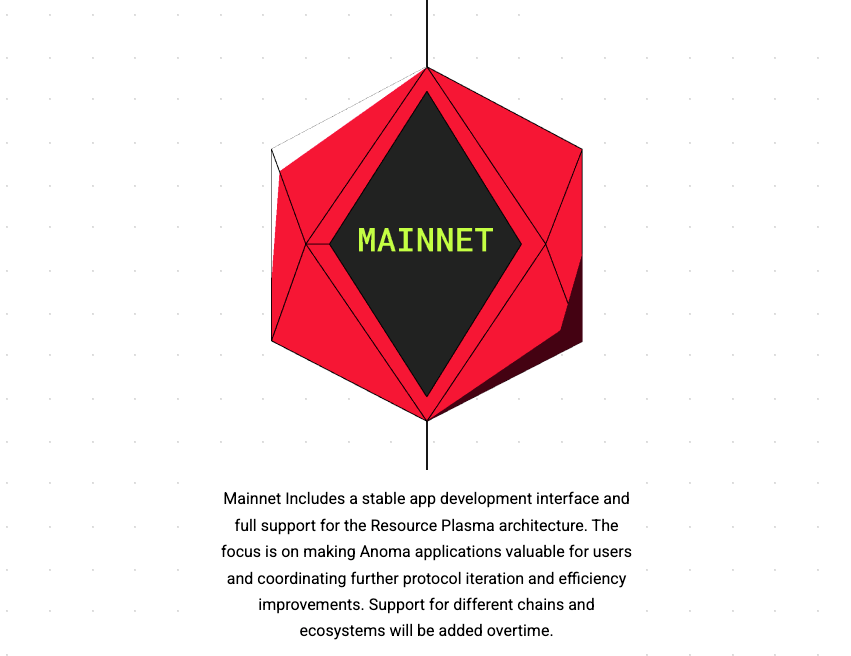
_Click to learn about the mainnet launch roadmap: _Anoma Blog
Key roles in the network include:
- Node operators: Running ANOMA nodes and participating in settlement
- Developers: Building privacy-focused applications
- Solvers: Matching intents and bridging liquidity between chains
- Users: Freely choosing the service combinations they use
Future development plans include:
- The first phase of the mainnet will support interoperability with Ethereum and its Layer 2 solutions.
- From the second phase onward, it will expand to other blockchains and introduce advanced privacy tools such as homomorphic encryption (FHE), multi-party computation (MPC), and Chimera chains.
- The native consensus mechanism of ANOMA and the final release of the mainnet token are also in planning.
Ultimately, whether ANOMA can become the new operating system of the Web 3 world will depend on the performance of early dApps and user feedback during the testnet period. Regardless of success or failure, it has already been a bold and profound exploration.
Frequently Asked Questions about ANOMA (XAN)
Q 1: What is ANOMA?
ANOMA is a blockchain protocol centered around "intent," where users do not need to manually write each step of a transaction but only express the results they want to achieve. The system automatically coordinates and completes operations, achieving atomicity, privacy, and cross-chain interaction.
Q 2: What is the XAN token?
XAN will be the native token of the ANOMA mainnet, used for staking, paying transaction fees, and incentivizing solvers, among other purposes. It has not yet launched but is expected to be released soon.
Q 3: What is NAM?
NAM is the native token of the Namada privacy chain, built on the ANOMA technology architecture. NAM supports staking, privacy rewards, and has been launched on several DEXs and some centralized exchanges.
Q 4: Where can I buy NAM/USDT?
You can purchase NAM on the Osmosis decentralized exchange or trade it on some centralized exchanges. On Osmosis, simply connect your Keplr wallet to trade NAM/USDT or NAM/ATOM.
Q 5: What is the current price of ANOMA?
Since XAN has not been released yet, there is currently no real-time price data. If you want to check the price of NAM/USDT, you can refer to market data on trading platforms like Osmosis.
Q 6: What are the main innovations of ANOMA?
ANOMA integrates "intent-driven execution," a solver network, atomic cross-chain coordination, and zero-knowledge privacy technology into a single platform, enhancing user experience and security.
Q 7: Is ANOMA similar to Cosmos or Ethereum?
ANOMA draws on some technologies from Cosmos, but its goals are more ambitious. Unlike Ethereum, ANOMA decouples the execution process from user operations and incorporates privacy protection.
Q 8: Where can I follow the latest updates on ANOMA?
You can follow the official X (formerly Twitter) account @anoma, join the official Discord community, or visit the official website anoma.net for information on the testnet, product updates, and community events.
免责声明:本文章仅代表作者个人观点,不代表本平台的立场和观点。本文章仅供信息分享,不构成对任何人的任何投资建议。用户与作者之间的任何争议,与本平台无关。如网页中刊载的文章或图片涉及侵权,请提供相关的权利证明和身份证明发送邮件到support@aicoin.com,本平台相关工作人员将会进行核查。




